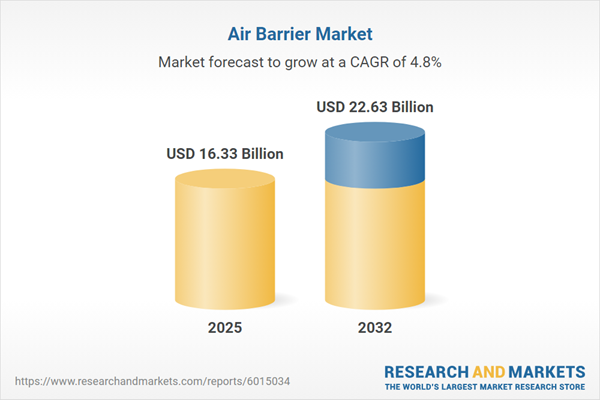Speak directly to the analyst to clarify any post sales queries you may have.
The air barrier market is undergoing rapid strategic change, shaped by evolving regulations, sustainability imperatives, and the rising demand for high-performance building enclosures. Senior decision-makers are prioritizing solutions that ensure ongoing compliance, operational continuity, and durable value across their real estate portfolios.
Market Snapshot: Air Barrier Market Performance
The global air barrier market continues to register consistent year-over-year growth, underpinned by a stable compound annual growth rate (CAGR). This momentum is driven by heightened regulatory scrutiny, accelerated uptake of green building practices, and significant innovation in membrane and enclosure technologies. Diverse construction markets—particularly North America, Europe, and Asia-Pacific—reflect a spectrum of compliance frameworks and procurement standards. The increasing emphasis on design resilience and energy performance is positioning air barrier systems as critical to the long-term reliability and regulatory conformity of commercial, industrial, residential, and infrastructure developments.
Scope & Segmentation: Executive-Level Market Insights
This report provides a comprehensive analysis to support informed procurement, capital planning, and executive alignment. Each segment is tailored to guide leaders in addressing regulatory shifts and evolving project requirements:
- Type: Evaluates the advantages and applications of liquid applied membranes, preformed sheets, self-adhesive products, and spray applied solutions. Each option is reviewed for its effectiveness in managing air and moisture across various construction settings.
- Material: Assesses acrylic-based membranes, bitumen-based options (including APP, SBS, and oxidized varieties), as well as polyurethane, silicone, CSPE, and EPDM synthetic rubber. Both mainstream and specialty technologies are compared for durability and adaptability.
- Application: Explores usage across curtain walls, doors and windows, façades, roofing systems, and wall cladding. The focus is on enhancing the complete building envelope for optimal durability and performance.
- End Use: Analyzes design and procurement approaches within commercial, industrial, infrastructure, and residential projects. Features distinct considerations for sectors such as healthcare, manufacturing, hospitality, and warehousing.
- Regions Covered: Reviews the impact of local construction codes, urban development patterns, and regulatory expectations in the Americas, EMEA, and Asia-Pacific. Emphasis is placed on aligning supply chains with regional standards and urbanization trends.
- Key Manufacturers: Profiles sector leaders including E. I. du Pont de Nemours and Company, GCP Applied Technologies Inc., MAPEI S.p.A., Sika AG, BASF SE, Carlisle Companies Incorporated, RPM International Inc., Compagnie de Saint-Gobain, SOPREMA S.A., and Johns Manville Corporation. Analysis highlights their roles in expanding distribution and advancing product innovation worldwide.
Key Takeaways for Senior Decision-Makers
- Ongoing material advancements and integration with digital monitoring tools simplify installation, providing greater transparency in both new builds and retrofit projects.
- Growing focus on responsible sourcing and the use of recyclable materials is reshaping supplier criteria and procurement policies across the construction sector.
- Collaboration among manufacturers, technology innovators, and sustainability experts is resulting in highly customized air barrier solutions that meet specific project objectives.
- Continuous evolution in international and local regulatory environments requires organizations to routinely evaluate and adjust compliance strategies, directly impacting competitive positioning and business partnerships.
- Establishing regional supply networks and nurturing supplier relationships are critical strategies for enhancing resilience to disruption and ensuring compliance with local building standards and urban development priorities.
Tariff Impact on Air Barrier Supply Chains
Recent U.S. tariff policies introduce greater complexity to sourcing and procurement. As a result, industry leaders are diversifying supplier networks and expanding local manufacturing capabilities. Proactive tariff risk analysis, integrated into procurement planning, supports the stability of air barrier supply chains and helps maintain healthy margins despite changes in trade conditions.
Methodology & Data Sources
This report draws from industry expertise and proprietary market models, using sources such as public records, sector association data, patent databases, and corporate financial disclosures. Rigorous analysis at every stage ensures that strategic insights remain relevant and actionable for executives navigating a dynamic market environment.
Why This Report Matters
- Delivers strategic guidance for procurement and compliance initiatives in the construction materials sector, facilitating sustainable and resilient supply chain decisions.
- Identifies critical technology and market segments, enabling targeted investments and efficient procurement planning.
- Equips senior leaders with the frameworks needed to adapt to evolving regulations and supply chain structures, supporting risk-informed partner and product selection.
Conclusion
Transformation within the air barrier market is being driven by regulatory demands, innovation, and operational objectives. This report offers the clarity and analysis required for senior leaders to develop forward-thinking, resilient strategies.
Additional Product Information:
- Purchase of this report includes 1 year online access with quarterly updates.
- This report can be updated on request. Please contact our Customer Experience team using the Ask a Question widget on our website.
Table of Contents
3. Executive Summary
4. Market Overview
7. Cumulative Impact of Artificial Intelligence 2025
Companies Mentioned
The companies profiled in this Air Barrier market report include:- E. I. du Pont de Nemours and Company
- GCP Applied Technologies Inc.
- MAPEI S.p.A.
- Sika AG
- BASF SE
- Carlisle Companies Incorporated
- RPM International Inc.
- Compagnie de Saint-Gobain
- SOPREMA S.A.
- Johns Manville Corporation
Table Information
| Report Attribute | Details |
|---|---|
| No. of Pages | 183 |
| Published | November 2025 |
| Forecast Period | 2025 - 2032 |
| Estimated Market Value ( USD | $ 16.33 Billion |
| Forecasted Market Value ( USD | $ 22.63 Billion |
| Compound Annual Growth Rate | 4.7% |
| Regions Covered | Global |
| No. of Companies Mentioned | 11 |









